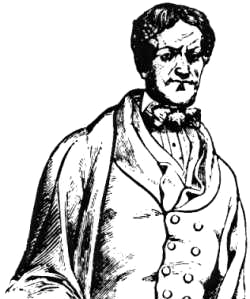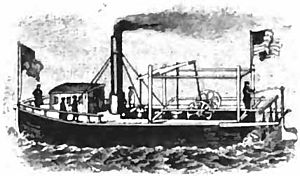John Fitch (inventor) facts for kids
John Fitch (born January 21, 1743 – died July 2, 1798) was an American inventor. He was also a clockmaker, a businessman, and an engineer. He is best known for running the first steamboat service in the United States.
Contents
John Fitch's Early Life
John Fitch was born on January 21, 1743, in Windsor, Connecticut. His family lived on a farm in what is now South Windsor, Connecticut. John didn't go to school much. Instead, he became an apprentice to a clockmaker. An apprentice learns a trade by working for a skilled person. Even though he was an apprentice, he wasn't allowed to learn how to make watches. But John was smart and later taught himself how to fix clocks and watches.
In 1767, he married Lucy Roberts. After his apprenticeship, he tried to open a business making brass in East Windsor, Connecticut, but it didn't do well. Then, he started a successful business in Trenton, New Jersey, making things from brass and silver. This business lasted for eight years. However, it was destroyed by British soldiers during the American Revolution.
During the American Revolution, Fitch worked as a gunsmith for the New Jersey militia. He helped fix and prepare weapons. Later, he supplied food and other items to the Continental Army soldiers at Valley Forge.
In 1780, he started working as a surveyor in Kentucky. A surveyor measures and maps land. He claimed a large piece of land for himself. In 1782, while surveying in the Northwest Territory, Native Americans captured him. They turned him over to the British, who later let him go.
Developing the Steamboat
By 1785, Fitch stopped surveying and moved to Warminster, Pennsylvania. There, he began to work on his big idea: a boat powered by steam. He tried to get money from the government, but they couldn't help. So, he convinced different states to give him a special right called a monopoly. This meant only he could run steamboats on their rivers for 14 years. With these monopolies, he found businessmen in Philadelphia to invest money.
Fitch had seen a picture of an early British steam engine. But these engines were huge and used for pumping water out of mines. He had heard about a better steam engine invented by James Watt in Scotland. However, no Watt engines were in America at that time. Britain didn't allow new technology to be sent to its former colonies. So, John Fitch decided to design his own steam engine. He moved to Philadelphia and got help from Henry Voigt, a clockmaker, to build a working model for a boat.
On August 22, 1787, Fitch's steamboat, named Perseverance, had its first successful test run. It happened on the Delaware River. Important people from the Constitutional Convention watched. The boat moved using a row of oars on each side.
Over the next few years, Fitch and Voigt kept improving their designs. In June 1790, they launched a new boat that was about 60 feet (18 meters) long. This boat used a steam engine to power several oars at the back. These oars moved like a duck's feet when it swims.
With this new boat, Fitch carried up to 30 paying passengers. They took many trips between Philadelphia and Burlington, New Jersey during the summer of 1790. The boat traveled thousands of miles and often went for 500 miles without breaking down. It could go at least 6 miles per hour, and sometimes even 7 or 8 miles per hour.
Fitch received a U.S. patent for his steamboat on August 26, 1791. He had to compete with James Rumsey, who also invented a steam-powered boat. The new Patent Commission didn't give Fitch the full monopoly he wanted. Instead, they gave him a patent for his specific steamboat design. Other inventors, like Rumsey, Nathan Read, and John Stevens, also received patents for steam engines on the same day. Because Fitch didn't get a full monopoly, many of his investors left his company. Even though his boats worked well, Fitch no longer had enough money to continue.
Twenty years later, Robert Fulton made steamboats profitable. Fulton was able to get a monopoly in New York State because his partner, Robert Livingston, was very powerful. However, Fulton struggled to get a U.S. patent because he couldn't prove his designs were completely new. Also, William Thornton, who had been part of Fitch's company, became the head of the new Patent Office. This made it even harder for Fulton to get a patent.
Fitch also received a patent from France in 1791. By 1793, he had lost hope of building a steamboat in America. He went to France, where an American investor, Aaron Vail, promised to help him. But Fitch arrived when the Reign of Terror was starting, a very difficult time in France. So, his plans there failed. He then went to London to try again, but that also didn't work out. He returned to the United States in 1794 and made a few more attempts to build a steamboat.
Later Life and Death
When his steamboat plans failed, John Fitch moved to Bardstown, Kentucky, in 1797. He hoped to sell some land he owned there to get money. He wanted to use the money to build a steamboat for the Ohio or Mississippi River. But when he arrived, he found people living on his land. This led to legal problems that lasted until he died.
While living in Kentucky, Fitch continued to work on ideas for steam engines. He built two models. One was lost in a fire. The other was found in his daughter's house in Ohio in 1849. This model is now at the Ohio Historical Society Museum in Columbus. In the 1950s, an expert from the Smithsonian Museum looked at it. He said it was "the first example of a working land-operating steam engine." This means it was an early design for a steam locomotive, a train engine that runs on tracks.
In 1802, an Englishman named Richard Trevithick invented a full-size steam locomotive. In 1804, it pulled the world's first train on tracks. Soon, this British invention led to the development of real railways. Americans later started importing and copying English locomotives.
John Fitch faced many failures, frustrations, and legal battles throughout his life. He died on July 2, 1798, at the age of 55, and was buried in Bardstown, Kentucky.
John Fitch's Legacy
Fitch's legal fights over state monopoly rights with other inventors, like James Rumsey, helped lead to the creation of the first Patent Act of 1790. This law helped protect inventors' ideas. Important historical figures like George Washington, Benjamin Franklin, Thomas Jefferson, and James Madison mentioned him in their personal letters.
Memorials to John Fitch
Even though he is not as famous as other American inventors like Robert Fulton, John Fitch's contributions are remembered. Many memorials and places are named after him:
- The John Fitch Steamboat Museum is located at Craven Hall in Warminster, Pennsylvania. It has a model of Fitch's first steamboat. The model is 6 feet (1.8 meters) long and weighs 100 pounds (45 kg).
- A large painting (fresco) in the United States Capitol from 1876 shows Fitch working on his steamboat models.
- A memorial to Fitch stands in Bardstown, Kentucky's Courthouse Square. It includes a copy of his first steamboat.
- A small monument to Fitch in Warminster, Pennsylvania, was moved in 2012 to the Craven Hall Historical Society site.
- John Fitch High School was built in Windsor, Connecticut, in 1922. It later became an elementary school and then housing for older adults. His name and picture are still carved into the building.
- The John Fitch Elementary School is in Levittown, Pennsylvania.
- The state of Connecticut named a section of US 5 in South Windsor and East Windsor "John Fitch Boulevard." This road runs near the Connecticut River.
- A small stone monument, put up in 1914, marks the spot where John Fitch was born in South Windsor, Connecticut.
- New Jersey named a part of NJ 29 in Trenton, along the Delaware River, the John Fitch Parkway.
- Fitch's own writings were published later as The Autobiography of John Fitch.
Images for kids
See also
In Spanish: John Fitch (inventor) para niños





